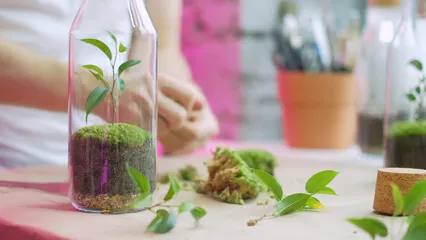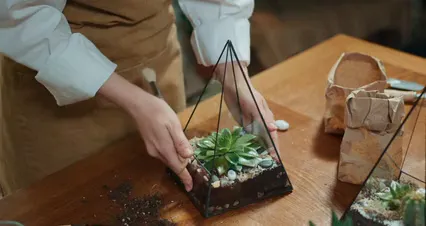
Live Terrarium Plants: A Complete Guide to Creating a Lush Indoor Ecosystem
Introduction
Live terrariums are mini ecosystems that bring nature indoors. They’ve gained popularity for their beauty and ability to enhance air quality. Adding live plants creates a vibrant atmosphere while improving your living space. This article will guide you in selecting, caring for, and maintaining your live terrarium plants.
Summary and Overview
Live terrarium plants are real plants used in closed or open containers. They play a crucial role in creating miniature ecosystems. Closed terrariums maintain high humidity, making them ideal for moisture-loving plants. Open terrariums, on the other hand, favor drought-tolerant varieties.
Using live plants in terrariums offers several benefits. They regulate humidity, add oxygen, and create a natural habitat for small creatures. Common plants for terrariums include Fittonia, ferns, and moss, each requiring specific care. Unlike artificial plants, live varieties contribute to a healthier environment and sustainability.
Speaking of sustainability, if you’re looking to add a touch of nature to your home decor, consider a Glass Terrarium Container. It’s the perfect home for your vibrant plants, offering a stylish way to showcase your green thumb.

If you’re interested in the role of moss in your terrarium, check out this article on my azalea arrived with moss is that bad for plants.
Understanding Terrarium Plants
What are Terrarium Plants?
Terrarium plants are live plants specifically chosen for mini ecosystems housed in glass containers. These plants thrive in the unique conditions of terrariums, which can be closed or open.
Closed terrariums create a humid environment, perfect for moisture-loving plants. Popular choices include Fittonia, ferns, and mosses. They flourish in these self-sustaining ecosystems.
Open terrariums, in contrast, suit drought-resistant plants. Succulents and cacti thrive here, enjoying good airflow and low humidity. If you’re looking for a delightful variety of succulents, check out this Succulent Plant Variety that will brighten your terrarium.
Did you know that terrariums have surged in popularity? A recent study found that interest in terrariums increased by 30% over the last two years. This trend shows that indoor gardening, including miniature gardens, is a hit with plant lovers!

Benefits of Live Plants in Terrariums
Using live plants in terrariums offers both aesthetic and biological benefits. Visually, they create a lush, vibrant display that brightens any space.
Live plants also play a key role in improving air quality. In fact, studies suggest that indoor plants can improve air quality by up to 20%. They release oxygen and help control humidity levels. For more on improving air quality indoors, check out this article on Best plants for improving air quality indoors.
For those who want to take their terrarium to the next level, consider adding some Live Moss for Terrariums. It’s a fantastic addition that thrives in humid conditions and adds a soft, lush layer to your miniature ecosystem.
Moreover, live plants contribute to healthier environments for pets, providing natural cover and enriching their habitats. This bioactive environment supports not just visual appeal but also a thriving ecosystem, benefiting both plants and creatures alike.
Selecting the Right Plants for Your Terrarium
Popular Terrarium Plants
Choosing the right plants is key to a thriving terrarium. Here are some popular options:
1. Fittonia (Nerve Plant): Known for vibrant leaves, Fittonia thrives in high humidity. It loves indirect light and enjoys moist soil. This plant adds a splash of color with its striking patterns.
2. Pilea: Often called the Chinese Money Plant, Pilea is easy to care for. It prefers bright, indirect light and moderate humidity. This fun plant has round leaves and can grow up to a foot tall.
3. Ferns: Many fern varieties, like the Boston fern, flourish in humid conditions. They require indirect light and need consistent moisture. Their delicate fronds create an elegant touch in any terrarium.
4. Peperomia: This compact plant is perfect for small spaces. Peperomia thrives in medium light and prefers drier soil. Its unique leaf shapes and colors make it a popular choice.
5. Moss: Moss is a classic terrarium staple. It loves moisture and thrives in low light. Moss creates a soft ground cover, adding texture to your miniature garden.
Each of these plants has specific care requirements, so be sure to check their needs before planting. For more visual inspiration, consider checking out images of these plants online to see how they can enhance your terrarium’s beauty.

Factors to Consider When Choosing Plants
When selecting plants, consider their light and humidity needs. Some plants thrive in bright spaces, while others prefer shade or indirect light.
Also, think about humidity levels. Closed terrariums retain moisture, making them ideal for humidity-loving plants. Open terrariums, however, suit drought-tolerant varieties.
Finally, monitor growth rates. Avoid plants that grow too large for confined spaces. Consider creating a chart to track the light and humidity preferences of your chosen plants. This will help you maintain a balanced ecosystem in your terrarium.
Setting Up Your Terrarium
Materials Needed
Creating a terrarium is a fun and rewarding project. To start, gather the essential materials.
First, you’ll need a container. Glass jars, fish tanks, or specialized terrarium vessels work well. Choose one that fits your space and style.
Next, select the right substrate. A mix of potting soil and organic materials like peat or Coconut Coir for Terrariums provides a healthy base. It’s important to ensure proper drainage, so consider adding perlite or small rocks for drainage.
You’ll also need decorative elements. These can include stones, driftwood, or miniature figurines for terrariums. They add character and enhance the visual appeal of your terrarium.
Finally, have some basic tools on hand. Tweezers for Planting and a Small Shovel for Terrariums can help with planting and arranging.
For your convenience, you can find quality terrarium supplies online. Check out this link for a range of materials.

Step-by-Step Guide to Creating a Terrarium
1. Choose Your Container: Pick a clear glass container to showcase your plants.
2. Layering: Start with a drainage layer. Add small stones or pebbles to the bottom. This layer prevents water from pooling.
3. Activated Charcoal: Place a thin layer of Activated Charcoal for Terrariums on top of the stones. This helps filter the air and keeps your terrarium fresh.
4. Add Substrate: Pour your soil mix over the charcoal. Aim for a depth of about 2-3 inches, depending on the plants you choose.
5. Planting: Use your tweezers to create small holes in the soil. Carefully place your plants in, ensuring they have enough space to grow.
6. Decorate: Add decorative elements like rocks or figurines. This personal touch makes your terrarium unique.
7. Watering: Lightly mist your plants with water. Be cautious not to overwater. Closed terrariums retain moisture, so check the soil regularly.
8. Placement: Find a suitable spot for your terrarium. Most plants thrive in indirect light. Avoid direct sunlight, which can overheat the container.
9. Maintenance: Keep an eye on moisture levels and plant health. Trim back overgrown plants and remove any dead leaves.
10. Enjoy: Take a step back and admire your creation! Terrariums can thrive for years with proper care.

Caring for Your Live Terrarium Plants
Watering and Humidity
Maintaining proper moisture levels is vital for your terrarium plants. Different plants have varying water needs. For instance, Fittonia loves consistent moisture, while succulents prefer drier conditions.
A good rule of thumb is to water your closed terrarium every 2-3 weeks. Open terrariums may need watering weekly. Always check the soil moisture before adding water; it should feel slightly damp but not soggy.
Humidity levels also play a significant role. Closed terrariums naturally retain moisture, creating a humid environment. You can use a Humidity Meter (Hygrometer) to monitor humidity. If it drops below 40%, consider misting your plants or adding a small dish of water.
Signs of overwatering include yellowing leaves and mold growth. Conversely, underwatering may cause wilting or browning leaves. To help you manage watering, consider a simple schedule:
– Closed Terrarium: Water every 2-3 weeks
– Open Terrarium: Water weekly
This template can guide your watering techniques and humidity control, ensuring healthy, vibrant plants.

Light Requirements
Light is crucial for the health of your terrarium plants. Most thrive in bright, indirect light. However, some plants, like ferns, prefer shadier spots.
If your plants need more light, consider using grow lights. Full-spectrum LED lights are excellent for this purpose, as they mimic natural sunlight. Place grow lights 12-24 inches above your terrarium, adjusting based on your plants’ needs.
Here are some recommended grow lights:
1. GE Grow Light LED: Ideal for low-light plants.
2. Miracle LED Grow Light: Perfect for larger setups.
3. Phlizon 600W LED Grow Light: Great for various types of plants.
Ensure your plants receive 12-16 hours of light daily. Check for signs of light stress, such as scorched leaves or leggy growth. Proper light exposure will help your terrarium flourish.

Pruning and Maintenance
Regular maintenance is key to a thriving terrarium. Pruning helps maintain plant health and encourages growth. Look for dead or yellowing leaves and remove them promptly. This prevents decay and keeps your terrarium looking fresh.
For most plants, trimming back about one-third of their height is sufficient. Use clean, sharp Pruning Scissors to avoid damaging the remaining plant. Consider taking before-and-after photos to track your plants’ progress.
Maintaining a consistent environment will also support plant health. If you notice excessive growth, it might be time to rearrange or replace some plants. Keep an eye out for signs of decay, such as mold or an unpleasant smell.
Regular pruning and maintenance will enhance your terrarium’s beauty and ensure its long-term success.

Troubleshooting Common Issues
Pests and Diseases
Pests and diseases can pose a challenge for your terrarium. Common culprits include aphids, spider mites, and fungus gnats. To identify these issues, check the undersides of leaves and around the soil.
Regularly inspect your plants for any signs of infestation. If you spot pests, remove them gently with a cotton swab dipped in Rubbing Alcohol for Pest Control. For larger infestations, consider using Insecticidal Soap or Neem Oil for Plants.
Preventative measures are essential. Ensure good air circulation and avoid overcrowding. This will help reduce humidity levels, making it less inviting for pests.
For a comprehensive pest control guide, consider keeping a checklist of common pests and their remedies. This proactive approach can save you time and effort in the long run.

Environmental Challenges
Environmental challenges can disrupt your terrarium’s balance. Mold growth is a common issue, often resulting from excessive moisture. To prevent mold, ensure proper airflow and avoid overwatering.
If you notice mold, remove affected plants and address the humidity levels. Adjusting the placement of your terrarium can also help. Opt for a brighter spot to improve air circulation and reduce moisture.
Poor drainage is another challenge. To combat this, make sure your terrarium has a proper drainage layer. Use small rocks or activated charcoal at the bottom to prevent water from pooling.
Lastly, inadequate light can hinder growth. If you suspect your plants aren’t getting enough light, consider adding grow lights or relocating your terrarium closer to a window. Addressing these environmental challenges will help your plants thrive.

Conclusion
In summary, caring for live terrarium plants involves monitoring watering, humidity, light, and maintenance. These plants enhance any indoor space and provide a rewarding hobby. Start your terrarium project today and enjoy the benefits of indoor gardening! Explore the joy of nurturing your very own green oasis.
Please let us know what you think about our content by leaving a comment down below!
Thank you for reading till here 🙂
All images from Pexels



